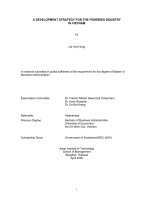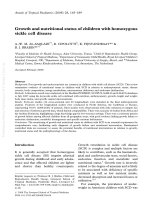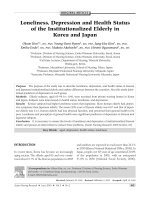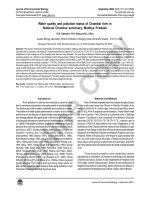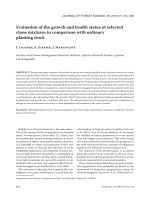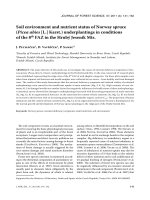INDUSTRY CHARACTERISTICS AND SOCIO-ECONOMIC STATUS OF FISHERIES INDUSTRY
Bạn đang xem bản rút gọn của tài liệu. Xem và tải ngay bản đầy đủ của tài liệu tại đây (428.06 KB, 66 trang )
A DEVELOPMENT STRATEGY FOR THE FISHERIES INDUSTRY
IN VIETNAM
by
Lai Huy Hung
A research submitted in partial fulfillment of the requirement for the degree of Master of
Business Administration
Examination Committee Dr. Fredric William Swierczek (Chairman)
Dr. Hans Stoessel
Dr. Do Ba Khang
Nationality Vietnamese
Previous Degree Bachelor of Business Administration
University of Economics
Ho Chi Minh City, Vietnam
Scholarship Donor Government of Switzerland/SDC (SAV)
Asian Institute of Technology
School of Management
Bangkok, Thailand
April 2000
i
Acknowledgement
I would like to express my sincere thankfulness and indebtedness to my research advisor Dr.
Fredric William Swierczek for his guidance, advice and encouragement through out the
research work.
My sincere thanks are also due to Dr. Do Ba Khang and Dr. Hans Stoessel for examining the
research work and giving valuable comments as the members of examination committee.
I would like to express thanks and appreciation to Prof. Hoang Xuan Thong – Director of
Institute of Fisheries Economics and Planning, Dr. Tran Huu Chinh – General director of
FIDICO, Miss. Nguyen Thi Nga – Planning vice director of Science, Technology and
Environment Department, Dr. Nguyen Thanh Hung – vice dean of fisheries faculty of HCMC
University of Agriculture and Forest, for providing information and interview. Without their
helping, this research would not have been possible.
I would like to express my sincere gratitude to all of my teachers and others at AIT and Swiss
Vietnam AIT Management Development Program for their teaching and supporting during my
course.
I would like to express my deeply appreciation to The Government of Switzerland who gave
me a great chance to participate in MBA study by providing financial support.
Special word of appreciation goes to my parents and family for their support, endurance and
encouragement throughout my study.
Last but not least, special thanks to my close friend and classmates for their friendship that
made my study more memorable with enjoyable and excitement.
ii
Abstract
Due to the resources lacking and to survive in the competitive world of Vietnamese fisheries
industry, it is necessitated to analyze the fisheries industry distinctly and explore factors. The
main objective of this research is to formulate a development strategy for Vietnamese
fisheries industry. A number of strategic formulation techniques are employed to analyze the
internal strengths and weaknesses, external opportunities and threats as well as the internal
linkages of the industry.
In general, Vietnamese fisheries industry has potential competitive advantages for
development. To exploit these potential advantages, it necessary to rationally manage and
control the balance development between sub-sectors as well exploiting the strengths of
these sectors.
It is suggested arrays of policies and regulations for strengthen competition of fisheries
industry, which are mainly focused on industry internal linkages and the rational exploitation
of natural resources.
iii
TITLE PAGE I
ACKNOWLEDGEMENT II
ABSTRACT III
LIST OF FIGURES VII
LIST OF TABLES VIII
INTRODUCTION 1
1.1 Background 1
0.1 Problem statement 1
0.2 Objectives 2
0.3 Approach to the study 2
0.4 Expected contribution 2
0.5 Scope of the study 2
0.6 Organization of the research 2
LITERATURE REVIEW 4
0.7 Strategic management process 4
0.7.1 Definition of strategy 4
1.1.1 Process of strategic management 5
0.8 Concept of industry environment 8
0.9 Industry analysis 10
1.1.2 Structural determinants of industry development 10
a) Threat of new entry 11
b) Rivalry among established companies 12
c) The bargaining power of buyer 13
d) The bargaining power of suppliers 13
e) The threat of substitute products 13
1.1.3 National determinants of industry development 14
a) Factor conditions 15
b) Demand conditions 15
c) Related and supporting industries 16
d) Firm strategy, structure and rivalry 16
1.1.4 SWOT analysis 16
INDUSTRY CHARACTERISTICS AND SOCIO – ECONOMIC STATUS OF
FISHERIES INDUSTRY 18
0.10 Organization and management 18
0.10.1 Ministry of fisheries (MoF) 18
0.10.2 State organization 18
0.10.3 Universities 18
0.10.4 Research Institutes 19
0.10.5 Other institutions and agencies 19
0.10.6 Extension services 19
0.11 Regional distribution of fisheries 20
0.11.1 Red river delta 20
iv
0.11.2 Northern Mountain 20
0.11.3 South central coast 20
0.11.4 Southeast area 20
0.11.5 Mekong River Delta 21
0.11.6 Mountainous and Middle high lands 21
0.11.7 Central highlands 21
0.12 Demography 21
0.12.1 Population and population growth 21
0.12.2 Age structure 22
0.12.3 Sex structure 22
0.12.4 Household structure 22
0.12.5 Agriculture and living land distribution 22
0.13 Workforces 22
0.13.1 Characteristics 22
0.13.2 Labor in fishery industry 23
0.13.3 Female labor 23
0.14 Income structure 23
0.15 Capital structure 23
0.16 Economic structure 25
0.16.1 State Owned sector 25
0.16.2 Collective sector 25
0.16.3 Private sector 25
0.16.4 Household sector 25
0.16.5 Foreign sector 25
0.17 Training and education 25
0.18 Incentive programs 26
0.19 Health care system 26
FISHERY INDUSTRY ANALYSIS 27
0.20 Fisheries exploitation 27
0.20.1 Aquatic resource 27
0.20.2 Fishing capacity 28
0.20.2.1 Fishing fleet capacity 28
0.20.2.2 Categories of fishing gear 30
0.20.2.3 Labor in fishing sector 31
0.20.3 Yield and productivity 31
0.20.4 Freshwater fish exploitation 33
0.20.4.1 Pond fish exploitation 33
0.20.4.2 Fish exploitation in low land areas 33
0.20.4.3 River fish exploitation 33
0.20.5 Conclusion 33
0.21 Fisheries aquaculture 34
0.21.1 Water Surface 34
0.21.2 Labor in Aquaculture Sector 35
0.21.3 Total Yield and Exported Value 35
0.21.4 Culture Method 35
0.21.4.1 Freshwater culture 35
v
0.21.4.2 Brackish shrimp culture 36
0.21.4.3 Marine culture 37
0.21.5 Extension service for aquaculture 37
0.21.5.1 Brood-stock hatchery system 37
0.21.5.2 Feed production 38
0.21.6 Conclusion 38
0.22 Fisheries Processing and Manufacturing 40
0.22.1 Raw material 40
0.22.2 Raw material processing 41
0.22.3 Processing and Manufacturing facilities in fisheries industry 41
0.22.4 Labor in fisheries manufacturing 43
0.22.5 Product categories 43
0.22.6 Food quality inspection and management 45
0.22.7 Conclusion 45
0.23 Fisheries trading 46
0.23.1 Foreign market 47
0.23.1.1 Exported value 47
0.23.1.2 Exporting market 48
0.23.1.3 Exported products 48
0.23.2 Domestic market 49
0.23.3 Conclusion 49
STRATEGIC INFORMATION AND RECOMMENDATIONS 51
0.24 Summary of analysis 51
0.25 Development strategy formulation 51
0.26 Recommendations 52
0.26.1 Fisheries exploiting 52
0.26.2 Aquaculture 53
0.26.3 Processing 54
0.26.4 Marketing and trade 55
0.26.5 Supportive industry 56
0.26.6 General 57
CONCLUSIONS 58
References
Appendixes
vi
LIST OF FIGURES
vii
LIST OF TABLES
viii
Chapter 1
Introduction
1.1 Background
Vietnam fisheries, being a long-standing one, are an important economic sector. Vietnam
fisheries productions contribute yearly more than 9% of GDP and attract a manpower of more
than 3 million people. The total output and export value of the fisheries industry continuously
increase respectively from 1,4 mill tones and USD 550 mill and in 1995 to 1,8 mill tones and
USD 980mill in 1999.
Though having great potential, Vietnam's fisheries sector remains underdeveloped. At
present, Vietnam has only 142 fishing ports, 22 others are in construction. Degrading major
infrastructures such as water supply, electricity and transport systems can not serve
development of the sector. In recent years, foreign investors have cancelled 44 out of 48 FDI
fishery projects. Merely 4% of capital for aquaculture are from foreign investment
1
.
Lacking money and knowledge, farmers have failed to develop effective aquaculture. 96.3%
of fish raising areas are of extensive cultivation which can generate low yields. Tens of
thousands of aquaculture farms have suffered from losses and bankruptcy when their fish die
or are not good enough to be exported due to lacking breeding technologies.
Vietnam now has 196 aqua-product processing factories. 70% of them have been working for
over ten years without upgrades. Due to insufficient investment, most enterprises and
families don’t have renovated equipment to increase their output. To date, the country has
only 27 enterprises qualified to export products to the European market. Around 81% of
aqua-product exports are sold at low prices. At a recent meeting of international donors for
the fisheries sector, Fishery Minister Ta Quang Ngoc said that Vietnam would need around
VND 3,112 bill in the coming time to develop the sector
2
.
0.1 Problem statement
Recently, Vietnamese government targets to raise the total output and export value of
fisheries industry to 2 mill tones and USD 2.5 bill, respectively, in year 2010
3
. Due to the
resources lacking and to survive in the competitive world it is necessitated to analyze the
fisheries industry distinctly and explore factors, which directly or indirectly influence the
improvement of this sector, to formulate the long-term development strategy for this industry
in Vietnam.
1
Ministry of Trade
2
Vietnam economic review: 1999
3
Economic Development Magazine: 2000, pp. 41
1
0.2 Objectives
1. To describe current performance of Vietnamese fisheries industry
2. To identify the structure and characteristics of internal linkages in the fisheries industry
3. To analyze and determine strengths and weaknesses of the fisheries industry.
4. To identify the barriers for development of Vietnamese fisheries industry
5. To formulate a development strategy for future development and improvement of the
fisheries industry in Vietnam.
0.3 Approach to the study
1. Mission: the mission of this research is to develop the fisheries industry in Vietnam.
2. Goal setting: to formulate a development strategy
3. Gathering information: primary data were gathered by unstructured interview with
fishing company, middle man, technical and academic institutes, related government
agencies and departments. Secondary data were gleaned by reviewing relevant texts,
government reports and publications.
4. Data analysis: before going to formulate the strategic plan, it is important to
understand the fishery business environment and this was done with the help of
Porter’s concept and SWOT analysis.
5. Formulation of strategic plan: after data analysis and data interpretation, a
suggested strategic plan is formulated.
0.4 Expected contribution
It is hoped that the research will be beneficial for the policy-makers as well as for fishery
business entities. It may also serve as a stimulus to boost the fisheries in the global market.
0.5 Scope of the study
This study is confined at national level for overall development of the fisheries industry in
Vietnam. The research geographically describes the fisheries industry and focus on industrial
linkage analysis, which can support the industry strategic formulation.
0.6 Organization of the research
The research consist of six chapters, which is further described as follow:
Chapter 1: Introduction chapter
2
Chapter 2: This chapter is a review of literature particularly on the concept of strategic
planning and the environment of fisheries industry.
Chapter 3: chapter 3 describes the performance and distribution of Vietnamese
fisheries industry, and aims at understanding the development of factors which directly
and indirectly supplements the performance of the fisheries industry in Vietnam.
Chapter 4: Industry analysis bases on the existing data with help of Porter’s concept,
SWOT matrix and cluster concept.
Chapter 5: This chapter is formulating a strategic plan and recommendation, which
aims at developing and improving the fisheries industry in Vietnam.
Chapter 6: Conclusion chapter
Figure 1. 1: Framework of the research
3
Problem identify
Objectives of research
Research methodology
Literature review Data gathering
Data analysis
Competitive advantage
(Strengths and weaknesses)
External environment
(Opportunities & threats)
Development strategy
Findings and recommendations
Chapter 2
Literature Review
This chapter dues with the theory foundation, which concern on the strategic development. It
is started with definition of strategic management and narrow down to the scope of study that
focuses on strategic formulation stage. A number of industry analysis techniques will be
examined to support the strategic formulation activities.
0.7 Strategic management process
0.7.1 Definition of strategy
Starting from its military root, strategy, ever considered as “the science of planning and
directing military operations”, is not a new term. However, applications of this concept into
business area is a breakthrough idea took place in the later half of this century. In the
decades of 1960s and 1970s, most management definitions of strategy by many authors
were emphasized on the planning them as an important component. Alfred Chandler has
defined strategy as “ the determination of the basic long term goals and objectives of a
enterprise, and the adoption of course of action and the allocation of resources necessary for
carrying out these goals”. The main idea in Chandler’s definition is that strategy involves a
rational planning process. The organization is depicted as choosing its goals, identifying
courses of action (or strategy) that best enable it to achieve its goals, and allocating
resources accordingly. Similarly, Quinn defined strategy as “ the pattern or plan that
integrates an organization’s major goals, policies and action sequences into a cohesive
whole”. Finally, Glueck defined strategy as “a unified, comprehensive and integrated plan
designed to ensure that the basic objectives of enterprises are achieved”. (Hill/Jones,1989)
However, definitions of strategy based on planning have been criticized. Hill and Jones
indicated a new approach based on Henry Mintzberg’s definition of strategy as “a pattern in a
stream of decisions or action” (Hill and Jones, 1989), the pattern being a product of whatever
intended (planned) strategies are actually realized and of any emergent (unplanned)
strategies. Mintzberg’s concept of strategy suggests that strategy involves more than just
planning a course of action
In the decades of 1980s and 1990s, “ strategy” becomes more and more essential in
business domain. Thereby, the concept of strategy has received a great attention by various
authors
Hax and Majluf (1991)pointed out that strategy can be seen as a multidimensional concept
that involves all the critical activities of the firm, providing it with a sense unity, direction and
purpose as well as facilitating the necessary change caused by its environment
(Glueck/Janch, 1986).
Johnson and Schole (1993) have stated the nature of corporate strategy by the
characteristics usually associated with the word ”strategy” or “strategy decision”
4
In summary, according to them, strategy is a unified, comprehensive and integrated plan that
relates the strategic advantages of the firm to the challenges of the environment and that is
designed to ensure that the basic objectives of the enterprises are achieved through proper
execution by the organization (Glueck/Janch,1986)
The concept of strategy has become one of everyday words of managers during the past 20
years and the practice of strategic planning is now widespread among large and medium
sized companies. This interest in strategy was caused by growing realization that the
company’ s environment has become progressively changeable and discontinuous from the
past and that as a result, objectives alone are insufficient as decisions rules for guiding the
company’s strategic reorientation as it adapts to changing challenges, threats and
opportunities.
1.1.1 Process of strategic management
Strategic management is a stream of decisions and actions that leads to the development of
an effective strategy or strategies to help achieve corporate objectives. The strategic
management process is the way in which strategists determine objectives and make strategic
decisions. However, strategic management is not simply the management of the process of
strategic decision making. According to Chakrvarthy (1986), strategic management is the
process through which managers ensure the long-term adaptation of their firm to its
environment. It should be also emphasized that strategic management process is continuous
– it never really stops within the organization. Certo and Peter (1990) defined strategic
management as “a continuous, integrative process aimed at keeping an organization as a
whole appropriately matched to its environment”
The process of strategic management involves three basic stages: (1) strategy formulation,
(2) strategy implementation, and (3) evaluation and control. Based on context of this study,
however, the focus will be on the strategy formulation process
Strategy formulation is often referred to as strategic planning or long range planning.
Regardless of the long term used, the process is primarily analytical, not action oriented. As
shown in the Strategic Management Model, the formulation process is concerned with
developing a corporation’s mission, objectives, strategy and policies. In order to do this,
corporate strategy makers must scan both the external and internal environments for needed
information on strategic factors.
Wheelen and Hunger (1998) detailed the first six steps commonly found in strategy
formulation are a series of interrelated activities:
1. Evaluation of:
• The corporation’s current performance results in terms of return on investment,
profitability and so on
• The corporation’s current mission, objectives, strategies and policies
2. Examination and evaluation of the corporation’s strategic managers- board of directors
and top management
3. Scanning of external environment to locate strategic opportunities and threats
5
4. Scanning of internal corporate environment to determine strategic strengths and
weaknesses
5. Analysis of the strategic factors from step 3 and 4 to
• Pinpoint problem areas, and
• Review and revise the corporate mission and objectives as necessary
6. Generation, evaluation and selection of the best alternative strategy appropriate to the
analysis conducted in step 5
However, the above strategy formulation process can be divided into 2 stages, as illustrated
in the figure 2.2
• The first stage is the situation analysis. Beginning with an evaluation of current
performance and ending with the review and possible revision of mission and objectives,
this stage includes step 1 through step 5
• The second stage is the process of generation, evaluation and selection of the best
alternative strategy. This stage is step 6
In order to construct an appropriate competitive strategy, a ”picture” of the competitive
environment is always a useful basic. In other words, there is clearly a need for competitive
environment analysis, an industry structure analysis.
6
Figure 2. 1: strategy formulation process
SITUATION ANALYSIS
(Source: Wheelen / Hunger, 1998)
Evaluate
current
perform-
ance
result
Examine &
evaluate
the current
Mission
Objective
Strategy
Policies
Evaluate
strategic
manager
s
Analyze
competitive
environment
Entry
Buyers
Suppliers
Substitutes
Competitors
Analyze
strategic
factors in
light of
current
situation
Develop:
Mission
Objectives
Scan external
Environment
Opportunities
Threats
Scan internal
Environment
Strengths
Weaknesses
GENERATION, EVALUATION, AND SELECTION OF THE BEST STRATEGY
7
0.8 Concept of industry environment
Organization can be considered as ecological entities and viewed as though they are
organisms that form mutual relationship with their environment. An organization’s ability to
cope with a changing environment is probably the most important determinants of its success
or failure in a free market system. The environment where a firm exists can be classified into
two types: internal environment and external environment.
According to Wheelen (1987), internal environment consists of variables that can influence
the firm’s success through the strategic factors of the firm itself. The variables are strengths
and weakness of the firm and it can be anticipated through the firm’s structure, culture and
resources (figure 2.3)
Figure 2. 2: variables of industry environment
Source: Wheelen (1987)
External environment consists of variables that can influence the firm’s success by elements
outside the firm. The variables are opportunities and threats, which come from elements or
Suppliers
Customers
Employee/ Labor
Union
Creditors
Special Interest
Group
Government
Stakeholder
TASK
ENVIRONMENT
(External)
Structure Culture
Resources
CORE
ENVIRONMENT
(Internal)
SOCIAL
ENVIRONMENT
(External)
Economic
Factors
Economic
Factors
Social
Factors
Social
Factors
Technological
Factors
Technological
Factors
Political
Factors
Political
Factors
groups that directly affect the firm’s major operation such as stockholders, government,
customers and suppliers. The social environment includes more general forces, which do not
directly affect the short-run activities of the organization but often influence its long-run
decision such as economic, socio-culture, technological and political-legal forces. Each of
these environments may have a distinct influence on decision making and organizational
action (Hanbrick, 1981; Brown and Utterback, 1985; cited from Elenkov, 1997)
Since there are many factors that need to be analyzed, the executive must be selective and
concentrate on those factors, which are critical for the enterprise. Furthermore, it is not
enough for the strategist to assess only the present environment. Planning for the future is
very much concerned with the more distant future.
In considering the factors affect on a firm’s business environment, Boulton (1984) mentioned
the variety of social, political, economic, and technological forces (figure 2.4).
Figure 2. 3: Factors Influencing the Competitive Business Environment
Sources: Boulton (1984)
Boulton had noted some of the social factors that affect business relate to the expectations,
norms, and attitudes of the communities in which business were operated. Political and legal
factors that develop out of social concerns include ecological legislation, health and safety
regulations, and the resulting concerns over too many regulatory and administrative controls.
New
Technology
Raw
Material
Social
Expectation
Social
Norms
Social
Attitudes
Ecological
Concern
Productivity
Capital
Saving
Rate
Employ-
ment
Demo-
graphic
Inflation
Rate
National
Economy
Health &
Safety
Regulatory
Controls
Admin.
Control
THE
COMPETITIVE
BUSINESS
ENVIRONMENT
Social Forces
Economic Forces
Technological Forces
P
o
l
i
t
i
c
a
l
F
o
r
c
e
s
9
Economic issues include a growing concern over national economic policies, inflation rates,
demographic changes, and employment levels and saving rates. Technological forces also
playing an increasing role in competition as a result of materials shortages, need for
productivity improvements, plant modernization, and increased investment in research and
development. The growing impact of these issues on business makes it difficult to consider
them independently, or even to set priorities as to their important.
0.9 Industry analysis
In the preface to his classic work, Competitive Strategy, Michael Porter argued that the field
of business strategy lacked an analytical base and contained few generalizable or robust
insights. He also noted that economists, whose work on industry and competition might
serve as the basic for the development of such insights. Porter’s book provide an important
illustration of how economic reasoning can inform and develop useful insight for practicing
managers, particularly with regard to strategies for dealing with a firm’s external environment.
Since the publication of Porter’s work researchers in economics and strategic management
have made significant strides in developing an understanding of both the external market
environment of firms and their internal organization.
1.1.2 Structural determinants of industry development
Although the roofs of the economics of industry and market competition field can be traced to
the 1930s or earlier, they had little impact on business strategy until Micheal Porter publish a
series of articles in the 1970s that cumulated in his pathbreaking competitive Strategy. In this
book, Porter presents a convenient framework for exploring the economic factors that affect
the profits of an industry. Porter’s main innovation is the classification of these factors into
five major forces. A five-force analysis systematically and comprehensively applies economic
tools to analyze an industry in depth. This model can use widely in any industry to facilitate
the formulating strategies to gain competitive advantage.
The five forces model originated from work by Porter (1997), as shown in the figure 2.5. This
model focuses on five forces that shape competition within an industry: (1) the threat of new
entry by potential competitors; (2) the degree of rivalry among established companies within
an industry; (3) the bargaining power of buyer; (4) the bargaining power of suppliers and (5)
the threat of substitute products. This model can be used for positioning an organization in
relation to market forces particularly through exploiting industry changes (Porter, 1979; cited
from Betts and Ofori, 1994)
10
Figure 2. 4: The Porter five forces model
Source: Porter 1979 (cite from Hill and Jones, 1998)
Porter suggested that the strength of these forces is the threat in the ability of the companies
to raise prices and earn profits. In contrast, the weakness of these forces can be viewed as
an opportunity for the companies to earn greater profits. The strength of the five forces may
change through time as industry change. The task of managers is to understand how change
of these forces generates new opportunities and threats an formulate appropriate strategies
a) Threat of new entry
Potential competitors are the companies that are not currently operate in the industry but
have capability to entry into the competition in the industry. Threats of new entrants can
effect the profitability of established companies.
The degree of potential competitors to entry the industry is depends on the barriers to entry.
These barriers are band loyalty, absolute cost advantage, economic of scale and government
regulation. High barriers to entry make potential competitor difficulty entry the industry since
it makes costly for them to establish new companies and survive in high competition
• Brand loyalty is the preference of buyers in the products of the established companies.
The established companies can create band loyalty through continuous products quality,
good after-sale services, product innovation and price advantage.
Rivalry among
established
company
Threat of entry
by potential
competitors
Bargaining
power of
buyers
Bargaining
power of
suppliers
Threat of
substitute
products
11
• Absolute cost advantage is the established companies in the cost of production due to
past experience, patents, skill in management of materials and equipment and access to
loan the money
• Economic of scale is the cost advantage that relevant with large company size. The large
companies have capability to dominate the price of products in the industry due to cost
reductions gained through mass producing a standard out put, the advantage gained by
spreading fixed costs over a large production volume, and larger volume of purchase raw
materials
• Government regulation is the policies that establish to protect some established
companies and buyers such as patents, law of consumer’s protection and law of
environment’s protection
b) Rivalry among established companies
Established companies are the companies that currently compete in the industry. High
competition lead to threat in profitability of established companies. Meanwhile, low
competition is the opportunity for the companies to raise prices and greater profits. The
extent of rivalry among established companies within industry is largely a function of three
factors: the industry’s competitive structure, demand conditions and the height of exit barriers
in the industry.
• Competitive structure refers to the number and size distribution of companies in an
industry. Structures vary from fragmented to consolidated and have different influence for
rivalry. The fragmented industry consists of many small and medium -size enterprises but
non of them dominate the industry. This type of industry is identified as low barriers of
entry and hard to differentiate the products. Many companies in the industry may lead the
price war because typical products and services may conduct buyers to interest in low
price; consequently many companies have to cut prices to maintain their market share.
This is the threat for profitability among rivalry. The consolidated industry is dominated by
a small number of large companies that are independent. The competitive activities of
one company effect the operation of others. The event that pushing profits down is, if one
company reduces prices of products, others can not stabilize their prices to earn greater
profits. The advantage of this industry is, if there is agreement among rivalry to raise
prices and earn more profits. This is disadvantage for buyers.
• Demand conditions are another factor of intensity of rivalry. Growing demand tends to
reduce rivalry since all companies can sell more and earn greater profits. Conversely,
declining demand causes decrease in buying power and more rivalry as companies’ fight
to maintain revenues and market share.
• Exit barriers are the factors that keep companies in the industry even when return are low.
Causes of these barriers depend on economy, strategy and emotion of companies. In
economic factor, companies may invest in plant and equipment that have no alternative
uses and can not be sold off; it is not worthwhile for them to leave the industry. In
strategic factor, companies only need to survive under crisis condition in order to wait for
next booming of the industry that earn them continuously.
12
c) The bargaining power of buyer
Buyers affect the competition when they are in the position to force down prices, demand
better service and bargain higher quality. Buyers can influence the competition by their
power to bargain with the companies. The circumstances that buyers are most powerful
include:
• Low demand from buyers that allow them to dominate supplier
• Buyers purchase large quantity, they can bargain for price reduction
• High supply from companies so buyers have several choices to purchase
• When suppliers depend on the buyers for large percentage of their total orders
• Buyers have capability to produce the products themselves
d) The bargaining power of suppliers
Suppliers affect the competition when they are able to force up prices, reduce the quality and
service of the input they supply. As with buyers, suppliers can influence the competition by
their power to bargain with companies. The circumstances that suppliers are most powerful
include:
• When there is small group of them sell the product to many companies
• When there are no competitive products
• When their products are differentiated that it is costly for a company to switch from one
supplier to another
• When the company’s industry is not an important customer of them. They can have little
incentive to reduce prices or improve quality
e) The threat of substitute products
Substitute products are the products that can serve the similar service or quality. Threat of
them can conduct companies to limit prices and earn greater profits. If substitutes are weak,
such as high prices or quality is not meet consumers’ requirement, it is opportunity for
companies to raise prices and earn more additional profits.
Among the five forces, Besanko et al.(1996) mentioned internal rivalry as the central factor
because it may be affected by each of the other forces. He also pointed out several
limitations of this framework.
• First, it is not especially concern with the magnitude or growth of demand. The
framework assumes that demand is sufficiently large for firms to be profitable under the
most favorable competitive conditions.
13
• The second, framework does not explicitly account for the role of the government, except
when the government is the supplier or buyer. The government as regulator can
profoundly affect industry profitability, and could be considered a sixth force.
• The third, the five-forces analysis is qualitative. For example, an analysis of industry
structure may suggest that the threat of entry is high, but the framework provides little
guidance about how to estimate the probability of entry. Because this is qualitative, the
framework is especially useful for assessing trends – that is, for determining whether
industry profitability is likely to increase or decrease.
1.1.3 National determinants of industry development
Many discussions, debates, and writing are made to explain the national competitiveness.
More recently, the review has gained favor that competitiveness is driven by government
policy. The best and suitable concept of conflicting at the national level is productivity (Porter,
1990). Productivity is the prime determinant of a nation’s long run standard of living. No
nation can be competitive in all aspects. The idea is to assemble the nation’s limited pool of
human and other resources into the best productive way. He argues that competition
advantage originates in the local environment in which the firm is based. This conclusion is
based on the detailed case studies of numerous industries that appeared in his book The
Competitive Advantage of Nations.
Like nelson and Winter, Porter views competition as part of an evolution process. Firms
initially gain competitive advantages by altering the basic of competition. They do so not just
by recognizing the existence of new markets or technologies but by moving aggressively to
exploit these opportunities. They sustain their advantages by investing to improve existing
sources of advantage and to create new ones. A firm’s home nation plays a critical role in
shaping manager’s perception about the opportunities that can be exploited; in supporting the
accumulation of valuable resources and capabilities; and in creating pressures on the firm to
innovate, invest and improve over time.
According to Porter, 1991, there are four basic attributes or determinants at national level that
affect the industry development. They are: factor of conditions, demand conditions, related
and supporting industries and firm strategy, structure and rivalry (figure 2.6).
14
Figure 2. 5: Determinants of national competitiveness
Sources: Porter(1991)
a) Factor conditions
The principle from Smith and Ricado (Classical economics) stated that a nation’s factors of
production, labor, land, natural resources, capital, infrastructure will determine the flow of
trade by exporting those goods that make most use of the factors which it is relatively well
endowed. But in the sophisticated industries that form the backbone of any advanced
economy, a nation doesn’t inherit but instead creates the most important factors of production
b) Demand conditions
Nations gain competitive advantages in industries where the home demand gives their
companies a clearer or earlier picture of emerging buyer needs and achieve more than their
foreign rivals. Also the larger the market segments in a nation, which receives the most
attention from the nation’s companies, helps to build competitive advantage.
Chance
Government
Factor
conditions
Demand
conditions
Firm trategy
structure and
rivalry
Related and
supoporting
industries
15
c) Related and supporting industries
An industry segment can gain benefit through association indirectly with an advantageous
industry segment that is upstream or downstream and contributory to the environment. The
presence of internationally successful related industry in a nation provides opportunities for
information flow and technical interchange, which can speed the rate of innovation and
upgrading
d) Firm strategy, structure and rivalry
These characteristics include strategies, structures, goals, managerial practices, individual
attitudes, and intensity of rivalry within the business sector. Also the competition between
domestic firms is more emotive and personal, and they reveal compete from a common
national platform, so they rivalry tends to be more intense than with foreign competitors.
Hence, domestic rivalry is particularly effective in promoting the upgrading of competitive
advantage
There are another two variables that also influence the national system. Those are chance
and government. Chance events occur in the condition outside the power of firms, as wars,
external political developments and pure inventions. These are also important since they
create discontinuities that shift competitive position in an industry. Government can influence
and be influenced by each of the four determinants, either positively or negatively.
Government has a direct dominion on national industries through its policies and regulations.
1.1.4 SWOT analysis
SWOT is an acronym for a firm’s key internal strengths and weaknesses and external
Opportunity and Threats. It is one of the most popular techniques for conducting situational
analysis attempting to find a strategic fit between external opportunities and internal strengths
while taking care of external threats and internal weaknesses. It is helpful in identifying firm’s
distinctive competence in terms of particular skills and resources possessed by the firm and
better way of utilizing them. The technique provides simple and systematic way of identifying
the relationship between the factors on which strategic are based
Weihrich (1982) proposed seven steps procedure for the analysis. They are as follows:
• Prepare an enterprise profile: the kind of business, geographic domain, competitive
situation, top management orientation
• identify and evaluate the following factors: economic, social, political, demographic,
products and technology and market and competition
• prepare a forecast, make predictions and assessment of the future
• prepare a strength-weakness audit in: management and organization; operations; finance;
marketing and others
• develop alternatives and
• make strategic choice
16
He classified the overall factors governing the firm’s strategy into two major groups namely
the external environment and the internal environment. External environment has been
further categorized as economic, social, political and demographic factors, products and
services, technology, market and competition that give rise to the opportunity and threat to
the firm. Similarly, internal environment which is responsible for the strength and weakness
of the firm, was classified as management and organization, operations, finance, marketing
and others
In the 2x2 matrix shown in the table 2.1, four conceptually distinct alternative strategies can
be observed. They are weakness-threat (WT) strategy, weakness-opportunity (WO) strategy,
strength- threat (ST) strategy and strength –opportunity (SO) strategy
Table 2. 1: SWOT (strength, weakness, opportunity and threat) matrix
Strengths (S)
List of 5-10 internal
strengths here
Weaknesses (W)
List of 5-10 internal
weaknesses here
Opportunities (O)
List of 5-10
external
opportunities here
SO strategies
Generate strategies here
that use strengths to take
advantage of opportunities
WO strategies
Generate strategies here that
use strengths to take
advantage of opportunities
Threats (T)
List of 5-10
external
opportunities here
ST strategies
Generate strategies here
that use strengths to take
advantage of opportunities
WT strategies
Generate strategies here that
use strengths to take
advantage of opportunities
Source: Wheelen and Hunger (1992)
External
Factors
Internal
Factors
17
